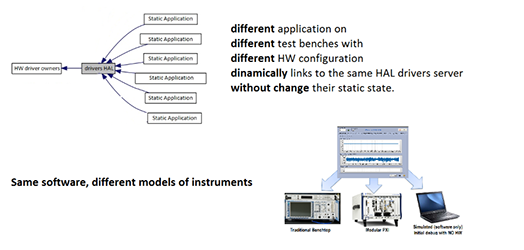LabVIEW如何减少下一代测试系统中的硬件过时6 点击:328 | 回复:0
LabVIEW如何减少下一代测试系统中的硬件过时6
HAL Benefits
When addressing obsolescence, HALs yield the benefits of lowermigration costs, faster migration time, higher code reuse, and easiermaintainability.
Lower Migration Costs
The act of designing a user-defined HAL helps you examine thoroughlyyour test system requirements and overall design. By modularizing your testsystem software into different levels, you avoid the extensive test applicationredevelopment that is necessary in a monolithic (nonmodular) test application.In addition to minimizing redevelopment, a user-defined HAL reduces theredocumentation and revalidation burden, which can translate directly intolower migration costs.

HAL的好处
在解决过时问题时,HALs带来的好处包括更低的迁移成本、更快的迁移时间、更高的代码重用和更容易的可维护性。
降低迁移成本
设计用户定义的HAL可以帮助彻底检查测试系统需求和总体设计。通过将测试系统软件模块化到不同的级别,可以避免在单一(非模块化)测试应用程序中所必需的广泛的测试应用程序重新开发。除了最小化重新开发,用户定义的HAL还减少了重新编制和重新验证的负担,这可以直接转化为更低的迁移成本。
Faster Migration Time
The lower migration costs are a direct result of decreasing themigration effort required. The decrease in effort also allows the migrationprocess to go more quickly. Having a well-designed and well-documentedexplanation of your HAL requirements allows developers to work on new DSSP codewhile the existing DSSP layers are used in the “production” (or released)system. This means you are better prepared for a test hardware migration thanyou would be with a traditional monolithic test application.
Higher Code Reuse
When you start with future reuse in mind, you are already ahead ofthe curve when it comes to system architecture. Following the best practice ofseparating test logic from the ASL minimizes dependencies and maximizes reuse.This greatly reduces the overlap of responsibilities and redundant developmentefforts. For example, the limit test uses an upper and lower limit with alinear mask on a frequency/amplitude table (array).
This can be reused by any instrument where a linear mask is testedby a 2D table (array). Isolating your ASL from instrument-specific code alsokeeps you from getting locked into a certain instrument model or manufacturer.
更快的迁移时间
较低的迁移成本是减少所需迁移工作的直接结果。工作量的减少还允许迁移过程进行得更快。对HAL需求有一个设计良好和文档完善的解释,允许开发人员在现有的DSSP层用于“生产”(或发布)系统时处理新的DSSP代码。这意味着与使用传统的单个测试应用程序相比,已经为测试硬件迁移做好了更好的准备。
更高的代码重用
当开始考虑将来的重用时,就已经走在了系统架构的前面。遵循将测试逻辑从ASL中分离出来的最佳实践,可以最小化依赖关系并最大化重用。这大大减少了职责的重叠和多余的开发工作。例如,极限测试在频率/振幅表(数组)上使用带有线性掩码的上限和下限。
这可以被任何用2D表(数组)测试线性掩码的仪器重用。将ASL与特定于仪器的代码隔离还可以免于被锁定在特定的仪器型号或制造商。
Easier Maintainability
The modularity of a user-defined HAL makes isolating and fixing bugseasier. In addition, you can focus any revalidation efforts on the module thatwas fixed, not the entire test application. When you design a user defined HAL,you must document the requirements for each part, which, in turn, allows you toknow what to test each part for. In many cases, the act of defining anddesigning your HAL exposes flaws in your original assumptions, whichfacilitates better system architecture. FreqSweep.vi in the ASL contains thelooping code that executes a frequency sweep. This simplifies the requirementsof the DSSP functions you need and gives you the power to use instruments thatdo not have a built-in frequency sweep capability. It also simplifies the timingbetween the output of the waveform at a certain frequency and the measurementof the maximum amplitude of the DUT at that frequency.
简单的可维护性
用户定义的HAL的模块化使得隔离和修复bug更加容易。此外,可以将任何重新验证工作集中在已修复的模块上,而不是整个测试应用程序。当设计用户定义的HAL时,必须记录每个部分的需求,这反过来又允许知道测试每个部分的目的。在许多情况下,定义和设计HAL的行为暴露了原始假设中的缺陷,这有助于更好的系统架构。FreqSweep ASL中的vi包含执行频率扫描的循环代码。这简化了所需的DSSP功能的要求,并够使用没有内置频率扫描功能的仪器。它还简化了某一频率波形输出与该频率DUT最大幅值测量之间的时序。
Summary
HALs separate the test application from the instrument hardware andhardware-specific software to streamline the upgrade process. The streamlinedupgrade process minimizes the time and costs associated with migrating testapplications. By isolating the software you have to modify, you reduce the costand effort of requalifying code. The other case of migrating existing hardwareto a new software application also benefits from HAL use.
In addition to the separation of test code and hardware, the mainHAL features are measurement compensation, API translation, and abackward-compatible and extensible API.
HAL options include standards-based (for example, IVI),user-defined, or vendor-defined and either an instrument-centric orapplication-specific API. You must weigh the different options and choose themost appropriate HAL type and API option. Because most test systems require amajor upgrade over their useful lives, a HAL reduces the time and costs ofmigrating test software to new hardware by minimizing the impact of new testsoftware development, revalidation, and redocumentation.
总结
HALs将测试应用程序与仪器硬件和特定于硬件的软件分开,以简化升级过程。简化的升级过程将与迁移测试应用程序相关的时间和成本最小化。通过隔离必须修改的软件,可以减少重新验证代码的成本和工作量。将现有硬件迁移到新的软件应用程序的另一种情况也受益于HAL的使用。
除了测试代码和硬件的分离之外,HAL的主要特性是测量补偿、API转换和向后兼容和可扩展的API。
HAL选项包括基于标准的(例如,IVI)、用户定义的或供应商定义的以及以仪器为中心的或特定于应用程序的API。必须权衡不同的选项,并选择最合适的HAL类型和API选项。因为大多数测试系统需要在其使用寿命内进行重大升级,HAL通过最小化新测试软件开发、重新验证和重新编制文档的影响,减少了将测试软件迁移到新硬件的时间和成本。
楼主最近还看过
- 三菱PLC仿真软件GX Simulato...
 [3396]
[3396] - 西门子PLC和安卓APP连接
 [7351]
[7351] - 组态王软件破解版无限点+视频...
 [3241]
[3241] - GX打开就出现工程初始化失败...
 [2482]
[2482] - TraceMode6的实时工业数据库
 [3331]
[3331] - 西门子精智系列触摸屏如何设...
 [3032]
[3032] - 求助:如何完全卸载s7-200
 [2566]
[2566] - 关于Engineering Base的问题...
 [2801]
[2801] - [不断更新中]FTP资料下载地址...
 [47971]
[47971] - PLC正在上载/下载,处于致命错...
 [2104]
[2104]

官方公众号

智造工程师
-

 客服
客服

-

 小程序
小程序

-

 公众号
公众号

















 工控网智造工程师好文精选
工控网智造工程师好文精选
